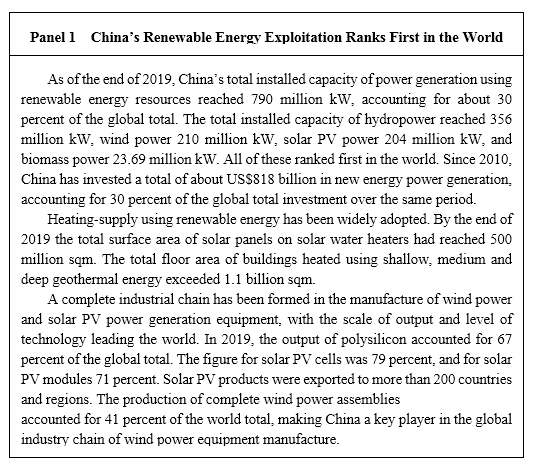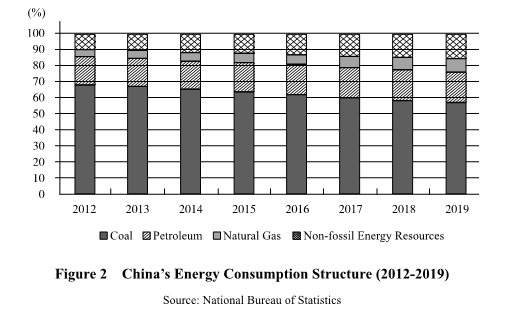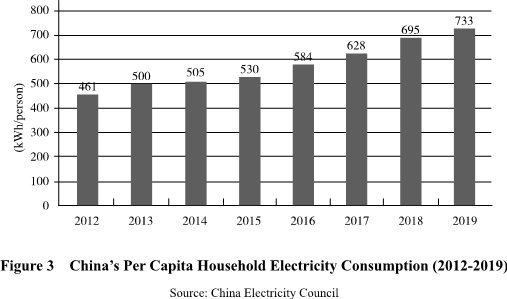Full Text: Energy in China's New Era
II. Historic Achievements in Energy Development
China is committed to driving an energy revolution. As a result, major changes have taken place in the production and use of energy and historic achievements have been realized in energy development. Energy production and consumption are being optimized, energy efficiency has increased significantly, and energy use has become more convenient for both work and life. China's capacity to ensure energy security has been strengthened. All this provides important support to quality economic development, victory in the battle against poverty, and building a moderately prosperous society in all respects.
1. Growing Capacity to Ensure Energy Supply
A diversified energy production infrastructure consisting of coal, oil, natural gas, electricity, nuclear energy, new energy and renewable energy is in place. Preliminary calculations show that China's primary energy production in 2019 reached 3.97 billion tons of standard coal, making it the world's largest energy producer.
Coal remains the basic energy source. Since 2012, the annual production of raw coal has ranged between 3.41 and 3.97 billion tons. Crude oil production remains stable. Since 2012, the annual production of crude oil has ranged between 190 and 210 million tons. The production of natural gas has increased notably, from 110.6 billion cu m in 2012 to 176.2 billion cubic meters in 2019. China's electricity supply capacity has risen to a cumulative installed capacity of 2.01 billion kW in 2019, up 75 percent since 2012, and an electricity output of 7.5 trillion kWh, up 50 percent. Renewable energy resources have expanded rapidly, with cumulative installed capacities of hydropower, wind power, and solar photovoltaic (PV) power each ranking top in the world. As of the end of 2019, the total installed capacity of nuclear power plants under construction and in operation reached 65.93 million kW, the second largest in the world. The installed capacity of nuclear power plants under construction ranked first.
Energy transport capacity has risen remarkably. China has built natural gas trunk lines measuring over 87,000 km, oil trunk lines totaling 55,000 km, and 302,000 km of electricity transmission lines of 330 kv or more.
The energy reserve system has been steadily improved. China has built nine national oil reserve bases; it has achieved preliminary results in building a natural gas production, supply, reserve and sale system; the coordinated guarantee system for coal production and transport is sound; the country has become a global leader in operating a secure and stable power grid; and its capacity in comprehensive energy emergency response has been strengthened significantly.
2. Remarkable Achievements in Optimizing Energy Conservation and Consumption
Significant improvement has been made in energy efficiency. Since 2012, energy consumption per unit of GDP has been reduced by 24.4 percent, equivalent to 1.27 billion tons of standard coal. From 2012 to 2019, China saw an average annual growth of 7 percent in the economy, while annual energy consumption rose by only 2.8 percent.
The shift towards clean and low-carbon energy consumption is accelerating. Preliminary calculations show that in 2019, coal consumption accounted for 57.7 percent of total energy consumption, a decrease of 10.8 percentage points from 2012; the consumption of clean energy (natural gas, hydropower, nuclear power, wind power) accounted for 23.4 percent of total energy consumption, an increase of 8.9 percentage points over 2012. Non-fossil energy accounted for 15.3 percent of total energy consumption, up 5.6 percentage points against 2012. With this China has reached the target of raising the share of non-fossil energy to 15 percent in total energy consumption by 2020. The number of new energy vehicles is rising rapidly. In 2019 the total number of new energy vehicles reached 3.8 million, with 1.2 million new energy vehicles going on road that year. Both of these figures represent more than half of the global totals. As of the end of 2019, there were 1.2 million electric-vehicle charging stations nationwide, constituting the largest charging network in the world, and effectively improving energy efficiency and optimizing energy consumption in the transport sector.
3. Rapid Improvements in Energy Technology
China continues to pursue technological innovation in the energy sector. Its energy technologies are continuously improving, and technological progress has become a basic driver for the transformation of the energy industry. There are complete industrial chains for the manufacturing of clean energy equipment for hydropower, nuclear power, wind power, and solar power. China has successfully developed and manufactured the world's largest single-unit hydropower generators, with a capacity of 1 million kW; it is able to manufacture a full range of wind turbines with a maximum single-unit capacity of 10 mw; and it continues to establish new world bests in the conversion efficiency of solar PV cells. China has built a number of nuclear power plants using advanced third-generation technologies, and made significant breakthroughs in a number of nuclear energy technologies such as new-generation nuclear power generation and small modular reactors. Its technological capabilities in oil and gas exploration and development keep improving. It leads the world in technologies such as the high-efficiency development of low-permeability crude oil and heavy oil, and a new generation of compound chemical flooding. The technology and equipment for shale oil and gas exploration and development have greatly improved, and successful natural gas hydrate production tests have been completed. China is developing green, efficient and intelligent coal mining technology. It has achieved mechanization in 98 percent of its large coal mines, and mastered the technology for producing oil and gas from coal. It has built a safe, reliable, and world-leading power grid which is the largest across the globe, with reliability of supply at the forefront of the world. A large number of new energy technologies, new businesses, and new models such as "Internet +" smart energy, energy storage, block chain, and integrated energy services are booming.
4. Significant Progress in Eco-Environmental Friendliness of the Energy Sector
China sees green energy as an important measure to enhance eco-environmental progress, and resolutely fights pollution, especially air pollution. Its capabilities in clean coal mining and utilization have greatly improved, and significant results have been achieved in regulating coal mining subsidence areas and building green mines. It has amended the Law on Air Pollution Prevention and Control to strengthen the prevention and control of pollution from coal and other energy sources, and ensure that more environmentally friendly energy sources are used to replace coal in equal or reduced amount in newly-built, renovated, or expanded coal-consuming projects in key areas for air pollution control. The green development of the energy sector has significantly improved air quality, and the emissions of sulfur dioxide, nitrogen oxides and soot have dropped notably. Green development of the energy sector has played an important role in reducing carbon emissions. By 2019, carbon emission intensity in China had decreased by 48.1 percent compared with 2005, which exceeded the target of reducing carbon emission intensity by 40 to 45 percent between 2005 and 2020, reversing the trend of rapid carbon dioxide emission growth.
5. Continuous Improvement in the Energy Governance Mechanism
China is making every effort to ensure that the market plays a greater role in the energy sector. Now, in a better business environment and a more viable market, market entities and individuals enjoy more convenient services and find it easier to start businesses. Market access for foreign capital in the energy sector has been extended, private investment is growing, and investment entities have become more diverse. Policies on power generation and consumption plans have been relaxed in an orderly manner, trading institutions can operate independently and in accordance with regulations, and the power market has further developed. China has accelerated reforms such as the deregulation of the oil and gas exploration market and the circulation of mining rights, reform of the pipeline network operation mechanism, and the dynamic management of crude oil imports. It has improved the construction of oil and gas trading centers. China encourages the market to play a decisive role in determining energy prices. It has further relaxed control on the prices in competitive areas, and has preliminarily established a reasonable pricing mechanism for power transmission and distribution and oil and gas pipeline networks. It coordinates energy reform with law-based governance, and the legal framework regarding the energy sector has been improved. An energy governance mechanism covering strategies, plans, policies, standards, supervision, and services is in place.
6. Solid Benefits for People's Lives
Ensuring public wellbeing and improving people's lives is China's fundamental goal in energy development. China is ensuring that urban and rural residents have access to basic energy supply and services, as a fundamental element in building a moderately prosperous society in all respects and supporting rural revitalization. From 2016 to 2019, the total investment in transforming and upgrading rural power grids reached RMB830 billion, and the average power outage time in rural areas was reduced to about 15 hours per year. The quality of power services for rural residents has improved significantly. From 2013 to 2015 China implemented an action plan to ensure access to electricity for every citizen, and completed this historic task by the end of 2015. It has implemented poverty alleviation projects based on solar PV power generation, and other energy-related poverty alleviation projects. China prioritizes poverty-stricken areas in planning energy development projects and has introduced energy projects for the benefit of the rural residents. This has promoted economic development in poverty-stricken areas and raised the incomes of the poor. It has improved the infrastructure for natural gas utilization, supplied natural gas to more areas, and improved its ability to ensure gas supply for people's daily life. Significant progress has been made in clean heating in northern China, with improvements in the energy use and living environment of urban and rural residents. As of the end of 2019, clean heating in northern China covered a floor space of 11.6 billion sqm, an increase of 5.1 billion sqm over 2016.






